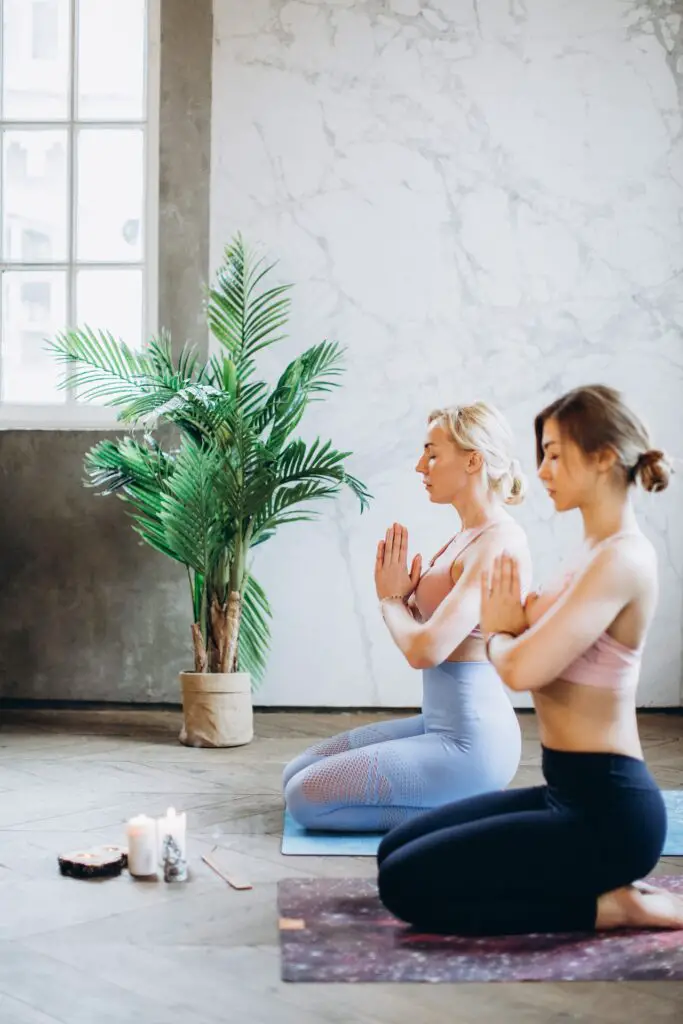
Yoga is one of my favorite practices because it connects me with my body and breath. It’s incredible that this ancient form has been around for centuries and continues to evolve. I’m excited to share these 12 yoga poses for 2 couples and besties. These yoga poses are fun, challenging, and accessible to everyone, regardless of experience level.
The beauty of yoga is that it offers so many benefits for both the body and mind. I feel more relaxed, robust, flexible, and grounded on my mat. Yoga helps me find balance and serenity in a world that can often feel chaotic.
When I practice yoga with a friend or loved one, I think of an even more profound sense of connection and community. It’s a way for me to share my joy and excitement of yoga and support each other in our practice. However, practicing yoga alone can sometimes feel lonely, so I enjoy partner or couples yoga.
Yoga poses for 2 offer so many benefits, both physically and emotionally. By practicing the poses together, we can help each other improve our strength, flexibility, and balance. We also experience the joy of moving and connecting with another person, whether a significant other or a good friend. Two-person yoga is a way to deepen our bond and feel more grounded in our relationships.
Whether you’re new to yoga or have been practicing for years, these yoga poses are a great way to explore yoga in a new way.
These yoga poses for 2 will help you strengthen your body, calm your mind, and deepen your bond with each other. So, grab a partner and get ready to move, breathe, and connect. Let’s get started!
Introduction to Yoga
Yoga is a practice of physical and mental disciplines that originated in ancient India. Yoga is derived from the Sanskrit root “yuj,” which means to join, yoke, or unite. This holistic practice has become famous worldwide as people seek peace and balance. I might add that those are excellent terms to remember while doing yoga for 2.
The history of yoga can be traced back thousands of years and is believed to have been developed by the Vedic culture in India. In the late 1800s and early 1900s, yoga began to gain popularity in the West, thanks partly to the efforts of Indian teachers like Swami Vivekananda and T. Krishnamacharya.
Yoga was initially intended to prepare individuals for spiritual enlightenment, but today it is widely practiced around the world as a form of exercise and relaxation.
There are many different types of yoga, each with its own poses or positions. Vinyasa yoga includes movement and dynamic flow between poses, while Ashtanga yoga is a traditional form following a fixed posture sequence.
Hatha yoga is the most common type of yoga practiced in the West. Hatha classes typically incorporate static postures that focus on stretching and breathing techniques.
Two-person yoga combines the benefits of traditional solo yoga with the added bonus of connection and support with another person. For those looking to increase the effectiveness of their yoga session, yoga poses for 2 allow couples, friends, or family members to do yoga together. It also allows each person to improve their practice by having another person help them with alignment, motivation, and balance.
2-person yoga poses allow partners to explore themselves and each other through trust and communication. Yoga poses can range from simple stretches to complex acrobatic movements, depending on everyone’s comfort and skill level.
Some yoga poses focus on physical strength, while others emphasize relaxation and joint mobility. Yoga poses for 2 also allow couples to cultivate intimacy and a deeper understanding of one another.
Anyone can do two-person yoga regardless of age or ability, making it a great activity for couples, families, and best friends.
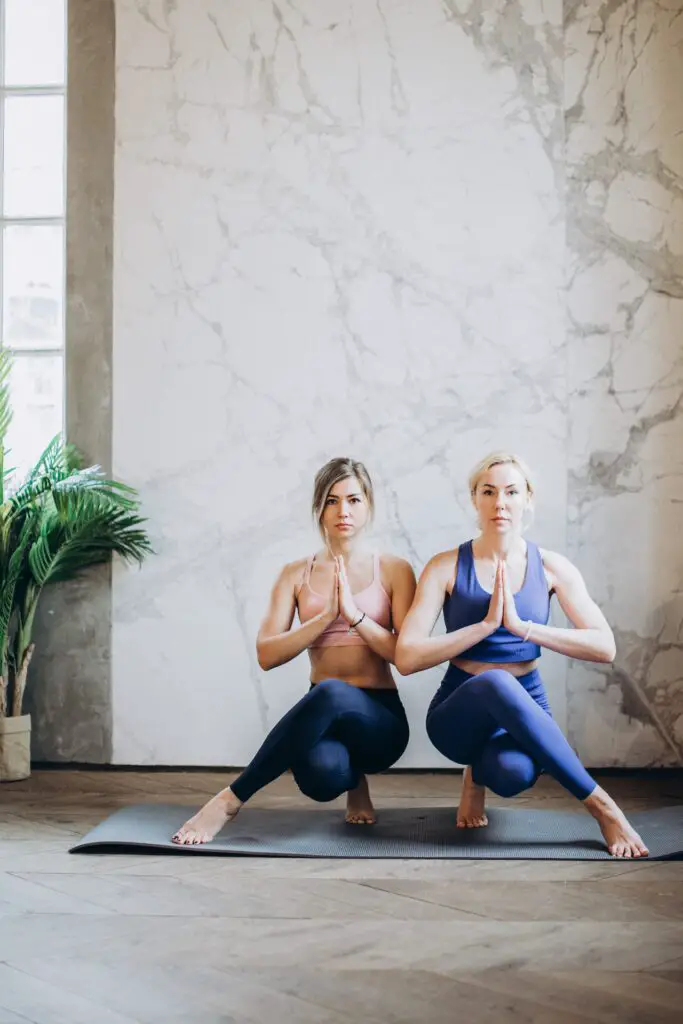
The Benefits of Yoga with a Second Partner
Yoga typically involves one person moving through various positions independently. However, yoga for two takes this practice to a new level, as two people work together in different poses and stretches.
With two people working together, yoga for 2 enables communication and trust-building between the individuals. A yoga session with a second partner has several physical and mental health benefits that cannot be experienced with a traditional solo yoga session.
Physically, two-person yoga can help increase flexibility and strength. Practicing with a partner gives each person extra support while performing the yoga poses they may be unable to do independently.
Holding some yoga poses for a few minutes requires each person to stay focused and relaxed. This can help improve balance and stability. In addition, partner-assisted yoga helps strengthen the core muscles, which are essential for strength and mobility.
On a mental level, two-person yoga can provide an experience of connection and community. Working with another person can open channels of communication that can increase feelings of trust and understanding.
The experience also encourages self-expression and growth within a supportive environment. Practicing partner/couples yoga poses have been found to reduce stress and anxiety, as the combined physical and emotional connection is deeply calming. 2 person yoga poses promote relaxation, requiring both participants to focus on their breathing and stay present in the moment.
The concept of two-person yoga is to use gravity and body weight to deepen a stretch and create balance. By using 2-person yoga poses, participants can support one another during stretching exercises, helping each other stay in proper form while challenging themselves at the same time. Physically supporting someone else’s body weight helps create a strong bond between the two people practicing the yoga poses. Partner/couples yoga poses also require synchronization and teamwork.
Working together on yoga poses can make reaching more profound levels of concentration easier, creating an opportunity for self-reflection and contemplation.
2 person yoga poses are a fun, safe way for two people to move through various yoga positions. It offers a unique way for two people to strengthen their relationship and has numerous mental and physical health benefits that cannot be achieved with traditional solo yoga poses.
12 Yoga Poses for 2
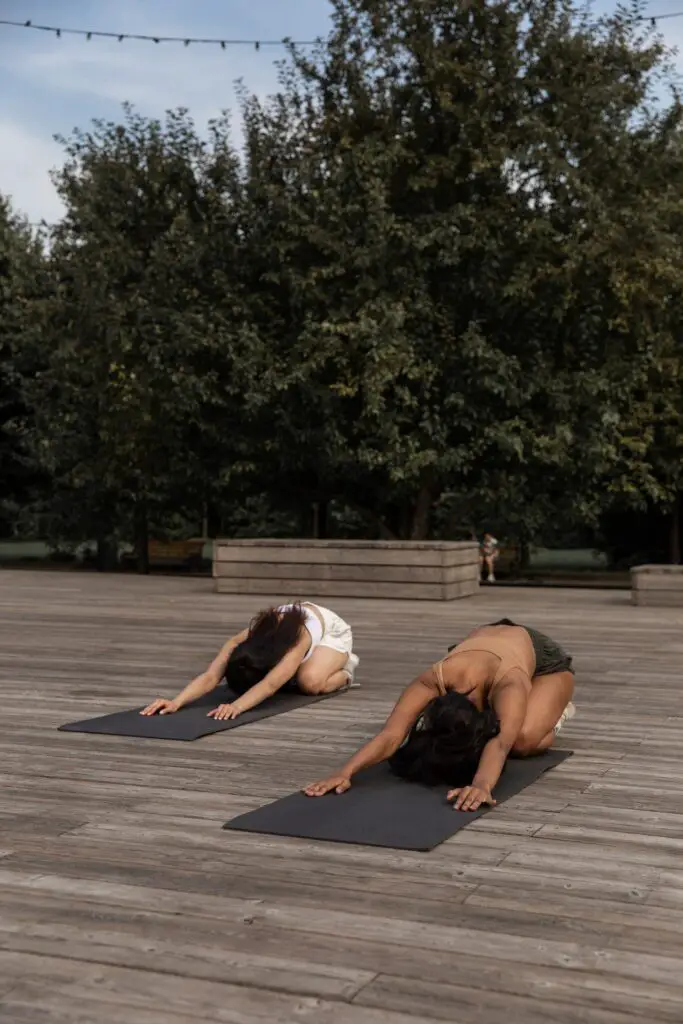
Double Child’s Yoga Pose
Let’s start with the Double Child’s Pose. This pose is a great way to begin your partnered yoga session. By sitting back on your heels and folding forward while holding hands, you can feel the gentle stretch in your back and hips, which helps to release tension and improve flexibility. It’s a relaxing pose that can help calm your mind and prepare your body for the next pose.
First, start on your hands and knees facing each other. Reach out and take each other’s hands. Sit back on your heels and fold forward, stretching your arms outward in front of you. Rest your forehead on the ground and breathe deeply.
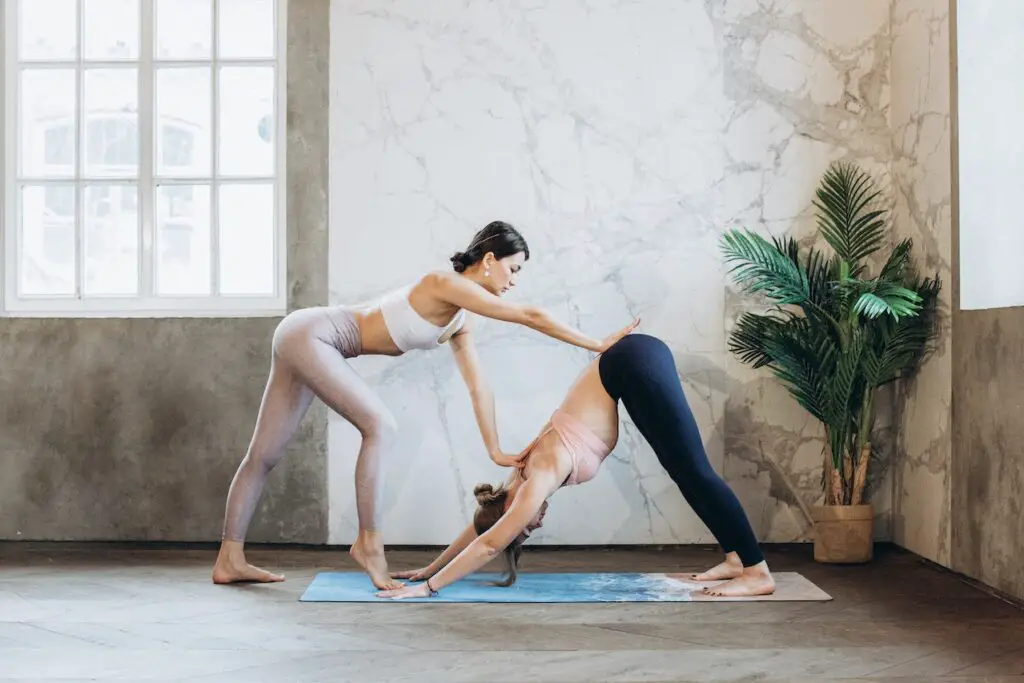
Double Downward Facing Dog
Next up is the Double Downward Facing Dog. It’s a bit more challenging than the Double Child’s Pose, but it’s a great way to stretch your hamstrings and calves. Your partner can gently press your lower back or hips to deepen the stretch, making it even more effective. Plus, having someone to support you can help you stay in the pose longer and achieve more significant benefits.
From a standing position, bend over and place your hands on the ground, keeping your feet shoulder-width apart to achieve the downward dog pose with your partner standing behind you for support. Remember to breathe deeply and relax into the stretch.
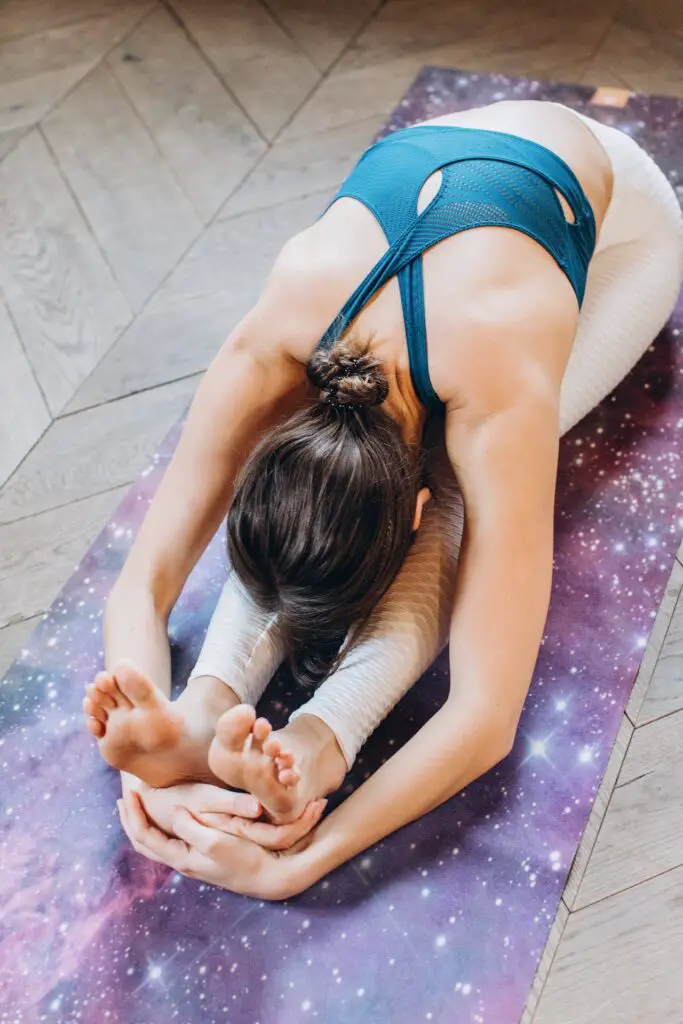
Seated Forward Fold Yoga Pose
The Seated Forward Fold yoga pose is another simple yet relaxing pose that helps stretch your hamstrings and lower back.
First, sit facing each other with your legs extended. Reach out, hold each other’s hands, fold forward, and keep your backs straight. Hold the pose and breathe deeply.
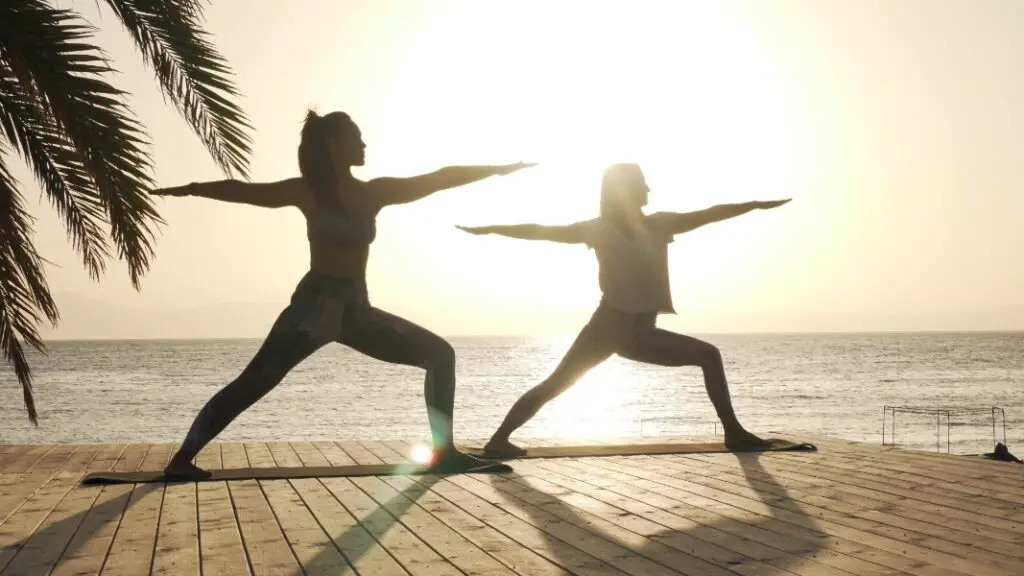
Double Warrior Yoga Pose
If you’re looking for a more challenging pose, try the Double Warrior. This yoga pose is an excellent way to build strength in the legs and core. It also helps to improve balance and stability. Holding hands with your partner can help to deepen the connection and create a sense of teamwork.
First off, stand facing each other with your feet hip-width apart. Take a big step back with your left leg; your toes should be at a 45-degree angle, your chest high, hips and pelvis forward, and your right leg should be slightly bent. Raise your arms overhead and lean back. This is Warrior I; hold and breathe deeply for a few seconds. Next, extend your arms to your sides and slightly rotate your left foot out to reach the Warrior II pose; as before, hold and breathe deeply for a few seconds.

Partner Twist
The Partner Twist is another yoga pose that can strengthen your connection with your partner. This pose is excellent for improving digestion, relieving spine tension, and providing a good stretch for the hips and lower back.
To start, sit back to back with your legs crossed. Place your right hand on your partner’s left knee and twist to the left. Your partner can place their left hand on your right knee and turn to the right. Relax and do the same to the opposite side. Relax, breathe deeply, and hold the stretch for a few seconds.
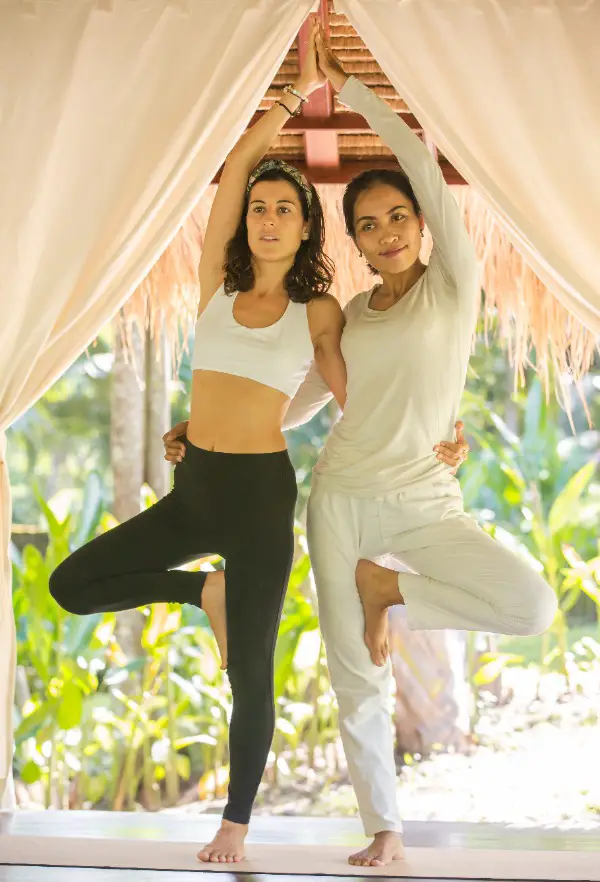
Double Tree Yoga Pose
The Double Tree pose is one of the fun, and slightly challenging standing poses to improve balance and focus. It also helps to strengthen the legs and core.
To begin, stand side by side with your partner, and place the sole of your right foot on your left inner thigh. Your partner will place the sole of their left foot on their right inner thigh. Reach your arms up, above your head, and the other arm across your body, hold hands and breathe deeply.
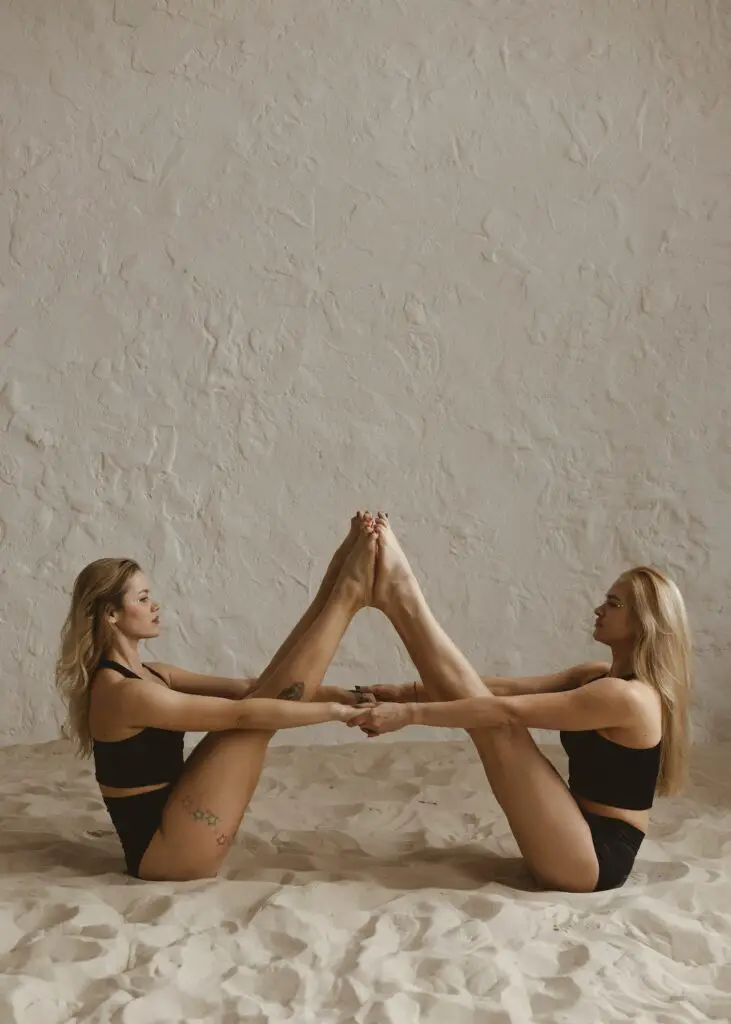
Buddy Boat Yoga Pose
The Buddy Boat yoga pose is one of the more advanced poses and a challenging core exercise that strengthens the abs and hip flexors. This challenging pose requires focus and coordination, making it an excellent choice for the team who want to push themselves.
To start, sit facing each other with your knees bent and feet flat on the ground. Reach out and hold hands, lift your legs, and put the soles of your feet together, coming into a boat pose. Hold this challenging pose and breathe deeply.
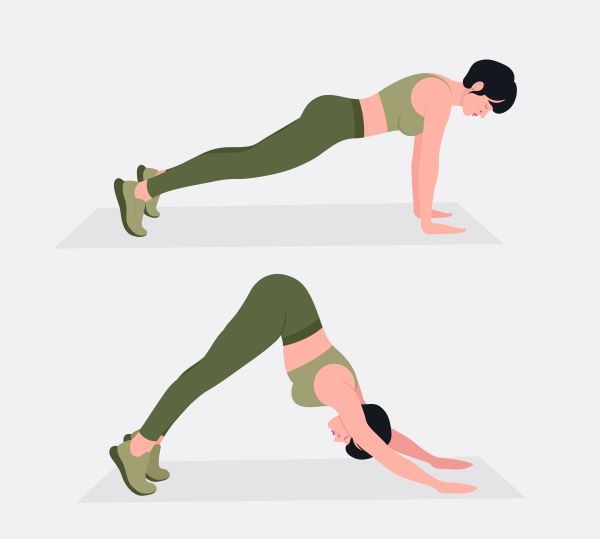
Double Downward Facing Dog Push-Up
The Double Downward Facing Dog Push-Up is a challenging pose that strengthens the arms and chest. Your partner can place their hands on your lower back or hips and lower themselves into a push-up, making it even more difficult. This pose requires strength and trust, making it a great way to build relationships with your partner. It’s also an excellent way to improve communication and teamwork between partners.
Start in a downward-facing dog pose. Your partner can place their hands on your lower back or hips to help lower you into a push-up. Slowly lower your hips until they are parallel to the ground, and you are in a plank position. From there, low your body as a unit to perform a push and return to the parallel position, then back to the downward dog position. Repeat for several reps, and remember to breathe throughout.
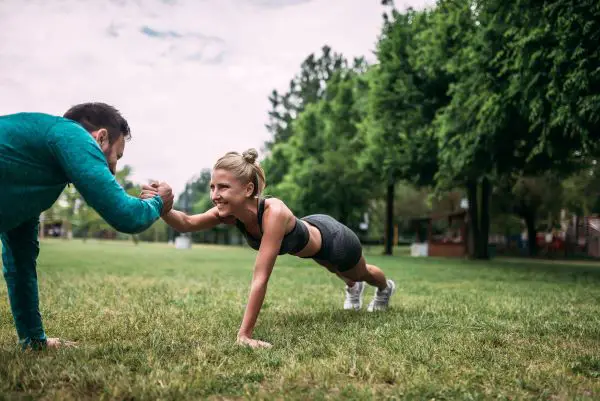
Partner Plank
The Partner Plank pose is a challenging pose that can help strengthen your core and upper body, to include your shoulders. Facing each other in plank pose and holding hands with your partner helps to deepen the connection and create a sense of support.
To start, you will assume the plank position, facing each other. Reach out with one hand and hold your partner’s opposite hand. Hold the pose with your core engaged, and breathe deeply.

Double Camel Yoga Pose
The Double Camel Pose is another relaxing pose that stretches the front of your body and improves posture.
To begin, kneel facing each other. Hold each other’s hands and lean back, keeping your hips and pelvis forward, and hold this pose as you feel the stretch. Relax and breathe deeply throughout the position.
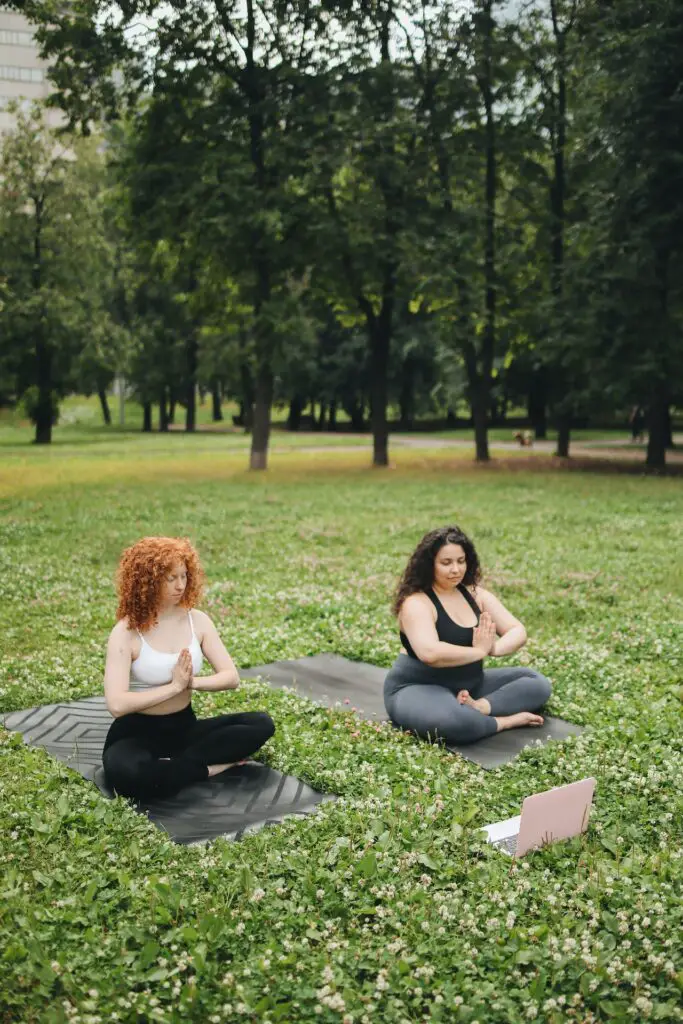
Double Pigeon Yoga Pose
The Double Pigeon Pose is a great way to get a deep stretch in your hips and lower back to relieve tension and improve flexibility.
Start by sitting facing each other with your legs crossed, one foot on the top and the other on the bottom. Lean your torso forward to stretch your back and hold hands to provide additional support, relax and breathe deeply.
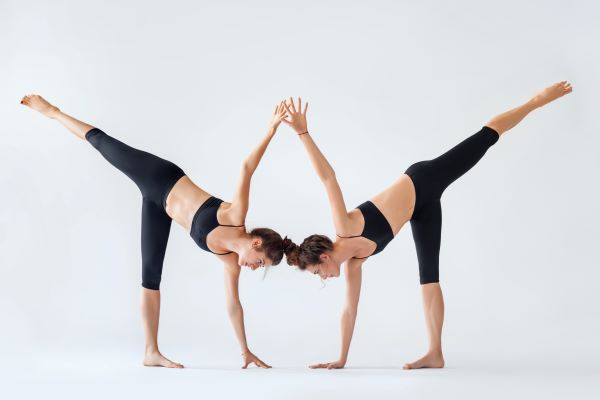
Double Half Moon Yoga Pose
Double Half Moon Pose is a challenging balance pose that helps to strengthen the legs and improve focus.
First, stand facing each other, and spread the feet shoulder-width apart. Relax and breathe throughout the movement, bend at the waist leaning to the right side, place the right hand on the floor, and slowly straighten the right leg. Begin to slowly lift the left leg off the floor. Once you are comfortable and balanced, reach straight up with the left hand as your partner does the same on the opposite side and hold hands. If you are off balance, you both can take turns performing the pose while the other person assists with maintaining the raised leg and arm for support.
The Wrap-Up
Yoga is an ancient practice with a rich history and numerous benefits for the body and mind. Practicing yoga regularly can increase your flexibility, build strength, improve your balance, reduce stress and anxiety, boost your mood, enhance your focus and concentration, improve your sleep, lower your blood pressure, and promote mindfulness.
Practicing yoga with a partner can be a fun and rewarding way to deepen your session and build a deeper connection with someone. By trying these 12 yoga poses for two people, you can take your yoga practice to the next level and enjoy the benefits of this ancient practice with a friend or loved one.



